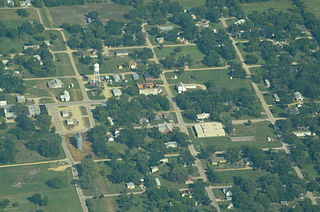
Green County is a county located in the U.S. state of Kentucky. Its county seat is Greensburg. Green was a prohibition or dry county until 2015.

Henderson County is a county located in the U.S. state of Illinois. According to the 2010 United States Census, it has a population of 7,331. Its county seat is Oquawka.

Hancock County is a county in the U.S. state of Illinois. According to the 2020 census, it has a population of 17,620. Its county seat is Carthage, and its largest city is Hamilton. The county is made up of rural towns with many farmers.

Glendale Heights is a village in DuPage County, Illinois, United States. Per the 2020 census, the population was 33,176.

Paxton is a city in Ford County, Illinois, United States. The population was 4,473 at the 2010 census. It is the county seat of Ford County.

Seneca is a village in LaSalle and Grundy counties in the U.S. state of Illinois. The population was 2,353 at the 2020 census, down from 2,371 at the 2010 census.

Carthage is a city and the county seat of Hancock County, Illinois, United States. The population was 2,490 as of the 2020 census, Carthage is best known for being the site of the 1844 death of Joseph Smith, founder of the Latter Day Saint movement.

Dallas City is a city in Hancock and Henderson counties in the U.S. state of Illinois. The population in 2020 stands at an estimate of 805, a decline from the 2010 census of 945, which was a decline from 1,055 in 2000.

Hamilton is a city in Hancock County, Illinois, United States. The population was 2,951 at the 2010 census, a decline from 3,029 in 2000. The city is located directly across the Mississippi River from Keokuk, Iowa. Hamilton is the largest city in Hancock County.

Nauvoo is a small city in Hancock County, Illinois, United States, on the Mississippi River near Fort Madison, Iowa. The population of Nauvoo was 950 at the 2020 census. Nauvoo attracts visitors for its historic importance and its religious significance to members of several groups: The Church of Jesus Christ of Latter-day Saints; the Community of Christ, formerly the Reorganized Church of Jesus Christ of Latter Day Saints (RLDS); other groups stemming from the Latter Day Saint movement; and the Icarians. The city and its immediate surrounding area are listed on the National Register of Historic Places as the Nauvoo Historic District.

Warsaw is a city in Hancock County, Illinois, United States. The population was 1,607 at the 2010 census, a decline from 1,793 in 2000. The city is notable for its historic downtown and the Warsaw Brewery, which operated for more than 100 years beginning in 1861 and, after renovation, reopened as a bar, restaurant and microbrewery in 2006.

Newton is a city in and the county seat of Jasper County, Illinois, United States. The population was 2,849 at the 2010 census, down from 3,069 at the 2000 census. Newton is home to a large coal-fired power plant operated by Illinois Power Generating Co and is close to Newton Lake State Fish and Wildlife Area and Sam Parr State Fish and Wildlife Area.

Millington is a village in Kendall and LaSalle counties in the U.S. state of Illinois. The population was 617 at the 2020 census down from 665 at the 2010 census,.

Yorkville is a city and county seat of Kendall County, Illinois, United States. The population was 21,533 at the 2020 census.

Corwith is a city in Hancock County, Iowa, United States. The population was 266 at the time of the 2020 census.

La Harpe is a city in Allen County, Kansas, United States. As of the 2020 census, the population of the city was 480.

Hancock is a city in Stevens County, Minnesota, United States. The population was 863 at the 2020 census.

Durham Township is one of twenty-four townships in Hancock County, Illinois, USA. As of the 2010 census, its population was 278 and it contained 129 housing units.

Illini West High School (IWHS) is a public high school in Carthage, Illinois, United States. IWHS serves a mostly rural area that includes most of northeastern Hancock County and extends into parts of Henderson and McDonough Counties, covering the cities of Carthage, Dallas City, and La Harpe, and the village of Ferris. The campus is located 25 miles (40 km) west of Macomb, Illinois, and has a student body of 332 students in grades 9–12 as of the 2017–18 school year. IWHS was established in 2007 as a consolidation of Carthage, Dallas City, and La Harpe High Schools and is housed at the former Carthage High School. The school is administered by the Illini West Community Unit School District 307, while the elementary and middle feeder schools in each of the communities that consolidated are administered by the Carthage Elementary School District 317, Dallas Elementary School District 327, and La Harpe Community School District 347.

Garner is a city in and the county seat of Hancock County, Iowa, United States. The population was 3,065 in the 2020 census, an increase from 2,922 in 2000.
























